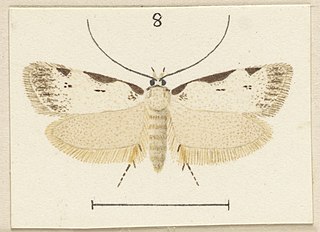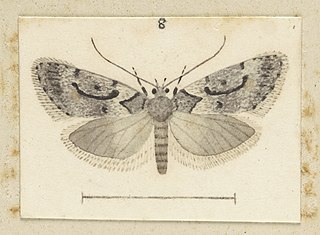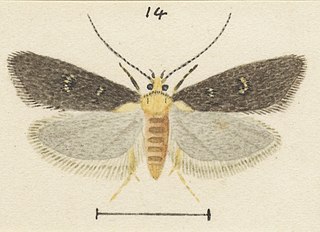
Izatha psychra is a species of moth in the family Oecophoridae. It is endemic to New Zealand. It is classified as Nationally Endangered by the Department of Conservation. In 2020 it was feared that this moth was extinct as a result of a fire at the Pukaki Scientific Reserve, the last known locality of this species. However a 2021 survey found I. psychra present in the small portion of the reserve that was not damaged by the fire.

Izatha apodoxa is a moth of the family Oecophoridae. It is endemic to New Zealand, where it is known from scattered localities in the southern North Island. This species is variable in appearance and comes in two forms, a grey form and a black and white form. In the grey form it is very similar in appearance to I. notodoxa and in the black and white form to I. katadiktya. At present the larvae and biology of this species is unknown.

Izatha balanophora is a moth of the family Oecophoridae. It is endemic to New Zealand, where it is widespread in the North Island. Larvae live off the dead bark of kānuka. The adult moths are on the wing during December to March.
Izatha dulcior is a species of moth in the family Oecophoridae. It is endemic to New Zealand. This species is classified as "At Risk, Naturally Uncommon" by the Department of Conservation. I. dulcior is the first lepidoptera species described as endemic to the Poor Knights Islands.
Izatha haumu is a species of moth in the family Oecophoridae. It is endemic to New Zealand. This species is classified as "At Risk, Naturally Uncommon" by the Department of Conservation. It is believed to only inhabit the Aupouri Peninsula.
Izatha quinquejacula is a species of moth in the family Oecophoridae. It is endemic to New Zealand. This species is classified as "At Risk, Naturally Uncommon" by the Department of Conservation. It is only found on the Three Kings Islands.
Izatha taingo is a species of moth in the family Oecophoridae. It is endemic to New Zealand. This species is classified as "At Risk, Naturally Uncommon" by the Department of Conservation. It is only known from the Aupouri Peninsula of Northland.
Izatha spheniscella is a species of moth in the family Oecophoridae. It is endemic to New Zealand. This species is classified as "At Risk, Naturally Uncommon" by the Department of Conservation. It is only found on the subantarctic Snares Islands.

Izatha prasophyta is a moth of the family Oecophoridae. It is endemic to New Zealand, where it is known from the North Island, except Hawkes Bay or the Wairarapa. Larvae likely feed on rotting wood although larvae of this species have been reared on the fruiting body of the bracket fungus Bjerkandera adusta. Adults are on the wing from November to February.
Izatha dasydisca is a species of moth in the family Oecophoridae. It is endemic to New Zealand. This species is classified as "At Risk, Naturally Uncommon" by the Department of Conservation.

Izatha manubriata is a moth of the family Oecophoridae. It is endemic to New Zealand, where it is known from the southern South Island only.
Izatha gibbsi is a species moth in the family Oecophoridae. It is endemic to New Zealand. This species is classified as "At Risk, Naturally Uncommon" by the Department of Conservation. It is named for George W. Gibbs.
Izatha minimira is a species of moth in the family Oecophoridae. It is endemic to New Zealand. This species is classified as "At Risk, Naturally Uncommon" by the Department of Conservation.

Izatha rigescens is a species of moth in the family Oecophoridae. It is endemic to New Zealand. This species is classified as having the conservation status of "Data Deficient" by the Department of Conservation. It is only known from the Wellington coast. This species has not been seen since 1929.

Ericodesma cuneata, the Corokia leafroller moth, is a species of moth in the family Tortricidae. It is endemic to New Zealand. This moth is classified as "At Risk, Naturally Uncommon" by the Department of Conservation.

Pyrgotis transfixa is a species of moth of the family Tortricidae. It is endemic to New Zealand. It is classified as "At Risk, Naturally Uncommon" by the Department of Conservation.

Hierodoris bilineata is a species of moth in the family Oecophoridae. It is endemic to New Zealand. This species is classified as "At Risk, Naturally Uncommon" by the Department of Conservation. It is possible that this species gives birth to live young rather than lay eggs as is the norm.

Hierodoris polita is a species of moth in the family Oecophoridae. It is endemic to New Zealand and is found only in the Central Otago region and in the Dunedin area. As at 2005 the larvae have yet to be identified. However it is possible that a specimen may have been collected in leaf litter thus leading to the hypothesis that the species may be a detritivore. The adults of this species prefer open habitat and have mainly been collected on south-facing rocky bluffs. The adult moths are on the wing in October, November and January to March. This species is classified as "At Risk, Naturally Uncommon" by the Department of Conservation.

Trachypepla cyphonias is a species of moth in the family Oecophoridae. It is endemic to New Zealand and has been collected in Wellington and Taranaki. Larvae of this species have been reared from kānuka leaf litter. Adults are on the wing in December. This species is classified as "At Risk, Naturally Uncommon" by the Department of Conservation.
Leptocroca xyrias is a species of moth in the family Oecophoridae. The taxonomy of this species is in need of revision and L. xyrias likely belongs to a separate genus. It is endemic to New Zealand. It has been classified as Data Deficient by the Department of Conservation.










